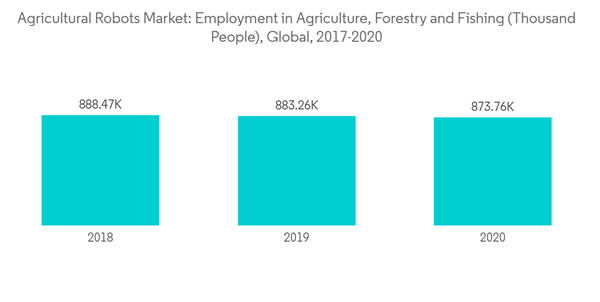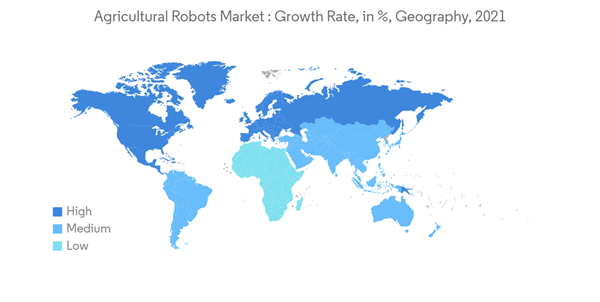The Agricultural Robots Market size is estimated at USD 14.97 billion in 2024, and is expected to reach USD 27.71 billion by 2029, growing at a CAGR of 13.10% during the forecast period (2024-2029).
This product will be delivered within 2 business days.
Key Highlights
- Agricultural robots, also known as agribots, are one of the latest revolutions in the agriculture industry. They are autonomous machines employed to improve the quality and efficiency of yield, increase overall productivity, and minimize reliance on manual labor. With the growing population, the demand for food is rising at a rapid pace globally. Thus, farmers are now shifting toward modern tools and equipment, such as agricultural robots, to boost their total productivity and generate more revenue.
- Furthermore, governments across the world are offering subsidies and undertaking initiatives to propagate awareness about automated technologies among farmers. For instance, in 2021, the European Union launched projects, such as Robs4Crops, from farming controllers and smart implements to fully autonomous farming systems. Robs4Crops (a new project) is helping farmers fill the labor shortage, which is shaking up the farming landscape. This is likely to enhance the scope of the agricultural robots market.
- Moreover, several established and start-up agricultural companies are investing in research and development activities to introduce an innovative range of agricultural robots. For instance, in 2021, AGCO Corporation launched the pilot of its Precision Ag Line (PAL) program, a tool designed to streamline support services for farming customers using AGCO solutions with mixed-fleet operations.
Agricultural Robots Market Trends
Labor Shortage and Increasing Costs of Labor
- The agriculture labor force has decreased in recent years due to the reduced interest in farming, combined with the aging farmer population. As the population of farm laborers continues to decline, farmers are feeling pressure to keep up with production for the growing demand for fresh produce. Moreover, the downward trend of labor is translating into higher labor wages.
- Furthermore, the agricultural industry in the United States and the United Kingdom, among other countries, depend on laborers, and a similar trend is seen across other developed countries as well. Agricultural employment has declined by 15% in the last decade around the globe, according to World Bank data. The labor shortage has become a global problem, with an aging farmer population that further limits the supply of manual labor. Thus, automated farming systems can help to reduce the pressures of the farm labor shortage. Agtech can bring new efficiencies to farm systems and drive overall productivity.
- Consequently, with a shortage of available workers, stakeholders are looking at how to modernize the farms. For instance, the American Farm Bureau Federation (AFBF) reported that 56% of US farms have begun using agritech, with more than half stating labor shortage as the reason. The use of innovative agrotechnology includes wireless sensors, robotics, predictive forecasting model, and data analytics. Thus, increasing labor shortages and wages are driving the growth of the market.
North America Dominates the Market
- North America accounted for the largest share of the agricultural robots market. The market in the region is driven by the higher adoption of advanced technology due to increasing labor shortage, high labor costs in the region, and high per-capita disposable income. Increasing government encouragement for the deployment of robots in agriculture, such as unmanned aerial vehicles, driverless tractors, and other agriculture systems to provide smart farming, are some of the factors contributing to the region's growth. To increase the yields and reduce the costs of farmers, some of the players in this market are heavily investing in developing cost-efficient and highly productive robots.
- For instance, in 2021, Future Acres, based in Santa Monica, launched its first robot, Carry, with plans to tackle grape picking. Carry relies on AI to transport hand-picked crops, working alongside humans. Hence, reducing the challenges of labor shortages and introducing new products into the market suiting the farmer's needs are driving the growth of the agricultural robots market in the North American region.
Agricultural Robots Industry Overview
The agricultural robot market is consolidated with active players competing on the basis of product quality and promotion and focusing on their strategic moves to hold larger market shares. Companies are investing heavily to develop new and cost-efficient products. They are also collaborating with and acquiring other companies to increase their market shares and strengthen R&D activities. The companies like AGCO Corporation, Deere & Company, Agrobot, and Agribotix LLC are some of the major players in the agricultural robots market.Additional Benefits:
- The market estimate (ME) sheet in Excel format
- 3 months of analyst support
This product will be delivered within 2 business days.
Table of Contents
1 INTRODUCTION
4 MARKET DYNAMICS
5 MARKET SEGMENTATION
6 COMPETITIVE LANDSCAPE
Companies Mentioned (Partial List)
A selection of companies mentioned in this report includes, but is not limited to:
- Agrobot
- Blue River Technology
- Harvest Automation
- AGCO Corporation
- Lely Industries
- Naio Technologies
- Precision Hawk
- Deere & Company
- AG Eagle LLC
- Agribotix LLC
- Trimble
- IBM
Methodology

LOADING...










